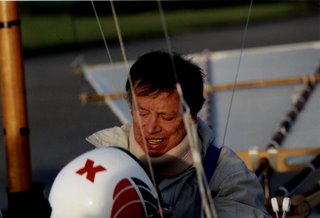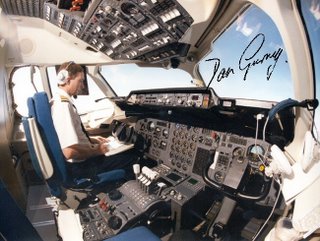Saturday, November 25, 2006
Friday, November 24, 2006
Thursday, November 23, 2006
Wg Cdr Inder Mohan Chopra (Chopie) 1932-2015

 After the the first flight of Basant HA 31 on March 30, 1972
After the the first flight of Basant HA 31 on March 30, 1972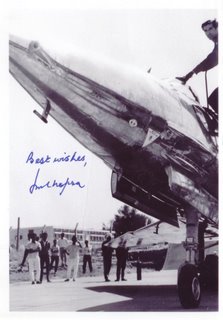
After the first flight of HF24 Mk 1A with Orpheus Engine Reheat
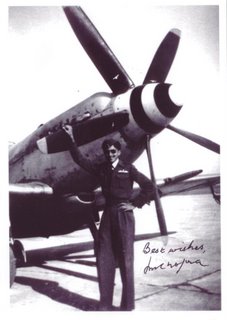 Wing Commander Inder Mohan Chopra (called Chopie).
Wing Commander Inder Mohan Chopra (called Chopie).He was born on May 3, 1932. He was commissioned in the flying branch of the Indian Air Force (IAF) on June 16, 1951 and was awarded the Sword of Honour for standing First in the course. He became a flying instructor in August 1953. Chopie graduated from Empire Test Pilots School UK in December 1957. Immediately after graduation he flew Hunters for production testing with Hawker Aircraft Ltd at Dunsfold, UK for six months. He was on deputation from the IAF to Hindustan Aeronautics Ltd. Bangalore (HAL) form January 1961 to May 1966. During this period he was actively involved in prototype development of the Marut HF 24. He carried out the first flight of HF24 Mk 1A with Orpheus Engine Reheat. Marut HF 24 Mk 1BX was modified for fitment of the Egyptian E300 engine on the right side with normal Orpheus engine on the left. It was the first Marut with twin hydraulic systems with no manual reversion. The tail plane and elevator were split but both were hydraulically operated. It was initially flown in Bangalore with the Orpheus fitted on both sides. Chopie did the first flight. The aircraft was then sent to Egypt.
Chopie was deputed to the Egyptian Aero General Organisaton, Helwan for flight development of the E300 engine in June 1966. A HAL team of about 25 headed by Gp.Capt. C. S. Naik (Retired as Air Marshal) was also sent to maintain the aircraft. The first flight with E300 engine fitted was done on March 29, 1967. A total of about 180 flights were done with the E 300 engine on the right and Orpheus on the left. The project was closed in July 1969.
Chopie prematurely retired form the IAF and joined HAL as the Chief Test Pilot. He carried out the first flight of Basant HA 31 on March 30, 1972. The aircraft was designed for agricultural spraying. The project was closed due to lack of interest by the Ministry of Agriculture. He carried out the first flight of HPT 32 (piston engine basic trainer) on January 6, 1977. The aircraft was designed for the IAF and is still being used.
In July 1980 he gave up flying and took the opportunity to work in management. He worked as General Manager of Overhaul Division and then the Aircraft Division. Later he became a Director on the Board of HAL and was the Chairman of the Company from April 1989. He retired form this position in May 1991. He is Fellow of the Aeronautical Society of India.
Tuesday, November 21, 2006
George S. 'Wheaties' Welch 1918-1954



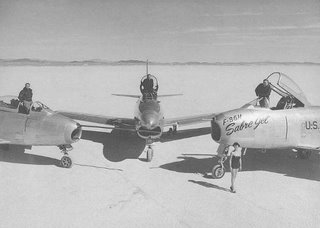
George Schwartz Welch became the first civilian pilot to exceed Mach
Lt Col Art Tomassetti 1964-

 LtCol Art Tomassetti was born in Port Chester, New York on March 13, 1964. He attended elementary schools in New York and Florida where he graduated from St. Thomas Aquinas High School in 1982. Lt. Col. Tomassetti was commissioned as a 2nd Lt in from the NROTC program in June of 1986. After completing The Basic School in Quantico , VA he began flight training in Pensacola, FL and continued on to Jet Training in Beeville, TX. Upon receiving his wings, he began flight training in the AV-8B Harrier in Cherry Pt, NC in 1988. He served with two Fleet Harrier Squadrons VMA-542 and VMA-513 and held a variety of billets including Standardization Officer, Weapons and Tactics Instructor, and Operations Officer. He made two 6-month deployments to the Western Pacific and spent 9 months in the Persian Gulf for Operations Desert Shield and Desert Storm. During Desert Storm, he flew 39 combat missions in the AV-8B Harrier throughout the Kuwait Theater of operations.
LtCol Art Tomassetti was born in Port Chester, New York on March 13, 1964. He attended elementary schools in New York and Florida where he graduated from St. Thomas Aquinas High School in 1982. Lt. Col. Tomassetti was commissioned as a 2nd Lt in from the NROTC program in June of 1986. After completing The Basic School in Quantico , VA he began flight training in Pensacola, FL and continued on to Jet Training in Beeville, TX. Upon receiving his wings, he began flight training in the AV-8B Harrier in Cherry Pt, NC in 1988. He served with two Fleet Harrier Squadrons VMA-542 and VMA-513 and held a variety of billets including Standardization Officer, Weapons and Tactics Instructor, and Operations Officer. He made two 6-month deployments to the Western Pacific and spent 9 months in the Persian Gulf for Operations Desert Shield and Desert Storm. During Desert Storm, he flew 39 combat missions in the AV-8B Harrier throughout the Kuwait Theater of operations.In 1997, he attended the United States Naval Test Pilot School in Patuxent River, MD in class 112. He was assigned to the Strike Aircraft Test Squadron where he conducted flight test in the both the F/A-18 and AV-8B aircraft. Lt. Col. Tomassetti served as a member of the Joint Strike Fighter Test Force and became the lead government pilot for the X-35 Test Team. He was the only U.S. government pilot to fly all three variants of the X-35 aircraft and flew the first ever Short Take-Off, level supersonic dash and vertical landing accomplished on a single flight. LtCol Tomassetti also served as the USMC JSF Program Integrator at the Lockheed Martin Facility in Ft. Worth TX. He has over 2900 hours of flight time in more than 30 different types of aircraft and is currently qualified in the F/A-18 and EA-6B.
LtCol Tomassetti reported back to Pax River in 2004 and is currently serving as the Commanding Officer for Air Test and Evaluation Squadron 23. He is a member of the Society of Experimental Test Pilots and on the Board of Directors for the John Glenn Squadron of the Marine Corps Aviation Association. He has a BS degree in Mechanical Engineering from Northwestern University and a MS in Aviation System from the University of Tennessee. LtCol Tomassetti is a graduate of the USMC Expeditionary Warfare School and Command and Staff College in Quantico, VA. His awards include two Defense Meritorious Service Medals, Air Medal with "V" device for Valor and numeral three, two Navy Commendation Medals, and the Navy Achievement Medal.
Friday, November 17, 2006
Albert (Al) W. Blackburn 1923-2011
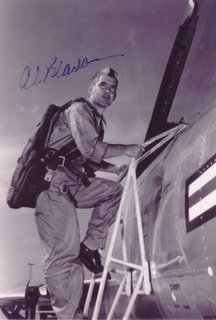

Al Blackburn is an engineer and test pilot who graduated from the US Naval Academy as a Marine, fought at Okinawa, returned to the States, and became a carrier-based fighter pilot. After leaving the service in 1949, he got a master's degree in aeronautical engineering from the Massachusetts Institute of Technology, then was recalled during the Korean war and spent a couple of years test flying for the Navy at the Naval Air Test Center at Patuxent River, Maryland. In 1954, he became an engineering test pilot for North American Aviation in Los Angeles. At the company's Palmdale flight test facility, he earned the title of Glider King when, within one two-week period, he experienced unrelightable flame-outs in three successive F-86 Sabrejet flights and managed to land all three craft. In 1957, he was asked to participate in the resurrected zero-length-launch project, and flew the maiden flight of the F100ZEL.
He later saw government service in the Department of Defense and with the Federal Aviation Administration where he was Assistant Administrator for Policy, Planning, and International Aviation. He is a charter member, founding director, and third president of the Society of Experimental Test Pilots..
Thursday, November 16, 2006
Peter Weger 1943 -


Peter Weger has beeen flying for 42 years,both Military,Civilian and Test Flying. He served in the German Air Force between 1963-1977 flying the F-104 Starfighter and F-4 Phantom and is a graduate of the Empire Test Pilots School. He retired as a Major.
He worked for Messerschmitt-Bolkow-Blohm GmbH for 8 years as a Test Pilot.Chief Pilot and manager of Flight Operations before joining Fairchild Dornier at Oberpfaffenhofen as Experimental Test Pilot.
He tested Tornado and was the pilot on the maiden flight of the Eurofighter 2000. He became involved with the Dornier 328 Jet project, and again made the maiden flight of that aircraft.
He has flown in excess of 10000hours and was awarded the Kincheloe award by the Society of Experimental Test Pilots for his achievements as a Test Pilot in 1994
Wednesday, November 15, 2006
William 'Pat' Patrick Ingram Fillingham 1914 -2003
 Pat Fillingham flying an early DH Chipmunk. He flew the maiden flight of the type
Pat Fillingham flying an early DH Chipmunk. He flew the maiden flight of the type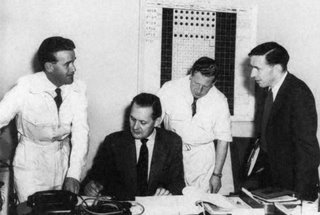 Pat Fillingham seated with DeHavilland Flight Test Crew
Pat Fillingham seated with DeHavilland Flight Test Crew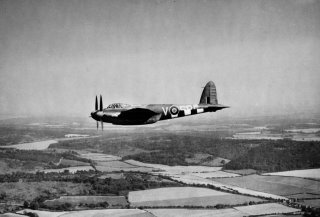
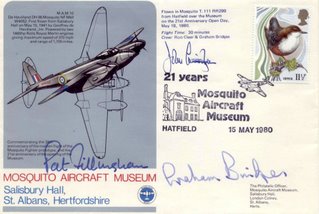
William Patrick Ingram Fillingham was born at Sutton Coldfield in 1914. He was educated at Worksop College and the de Havilland Aeronautical Technical School. He learnt to fly in the RAF Volunteer Reserve at Perth, soloing in a Tiger Moth in February 1937 and qualifying for his RAF wings in November 1938. On graduating as an aeronautical engineer in 1939 he joined the de Havilland Aircraft Company as a junior test pilot.
War brought big orders for new production aircraft, each of which had to be meticulously flight-tested. By April 1940 he was making more than 150 flights a month, mostly clearing new Tiger Moths. By September 1942, as chief production test pilot, he was making 30 Mosquito sorties a month.
In 1943 de Havilland sent him to Toronto and Sydney, where additional production lines were now rolling out de Havilland’s formidable “unarmed bomber with fighter speed”. His job was to advise the local de Havilland companies on Mosquito flight-testing. While in Canada he demonstrated Toronto-built Mosquitoes at a dozen military air bases, helping to win a substantial USAAF order. Back in England, where Mosquito production was running at five aircraft a day, he found himself flying more than 100 Mosquito test sorties a month. He flew more than 2,200 Mosquito sorties, undoubtedly a record. In 1944 production of the DH103 Hornet — the world’s fastest propeller fighter — added to the workload. Though the Mosquito always remained his favourite aircraft, he so admired the Hornet that he once flew it wearing a bowler hat.
He was quite a reserved person, never giving interviews or making speeches, but colleagues unfailingly recall his sense of humour. In September 1940, when the Battle of Britain was raging overhead, the boffins asked him to test a new atmospheric instrument. This meant flying an unarmed Dominie biplane at 15,000ft over southern England. When his flight-test engineer asked what they were supposed to do if they encountered a Messerschmitt, Fillingham said: “Don’t worry, I’ll wave my Nazi armband” — which he duly wore.
Peace brought big export and home orders for Dove and Heron commercial transports, Chipmunk trainers and Vampire jet fighters. Mosquitoes and Hornets were also still rolling off the production lines, joining the queue for air tests, demonstrations, customer crew-training, ferry flights and customer deliveries. In 1947, back from his Chipmunk work in Canada, he logged each of those types in one month.
Later in the 1950s, as de Havilland struggled to recover from the Comet 1 disasters, Fillingham turned his skills to testing the modified and redesigned Comets. He flew RCAF Comet 1As, RAF Comet 2s, BOAC Comet 4s, BEA Comet 4Bs, Mexicana Comet 4Cs, and variants for export customers. He took particular pleasure in delivering BOAC’s first Comet 4s to Heathrow in September 1958. The following month one of these inaugurated the world’s first transatlantic jet services, beating Pan American’s Boeing 707s. When that plane was retired by Dan-Air, he flew it to the Duxford air museum.
After the Comet 4s came the Trident series of trijet airliners, which came off the Hatfield production line from 1963. The Trident was the fastest subsonic jet airliner ever, and the first to be certificated for automatic landings in zero visibility. Customer crew-training took Fillingham to many countries. His most notable assignment, in 1972, was the delivery of China’s first Western jet airliner. He and a fellow test pilot flew CAAC’s first Trident from Hatfield to Canton. His logbook records: “Acceptance, 2 Test Frights — crew unable to speak a word of English.” He made further visits to China, and trained Chinese crews.
He retired in 1975 as deputy chief test pilot of Hawker Siddeley Aviation (into which de Havilland had been merged). In the last years of his career he enjoyed shuttle-flying the company’s 125 executive jets around Europe, and displaying his beloved Mosquito T3 RR299 at air shows. When he made his last flight he had flown 11,450 hours and 120 different aircraft types, including such rarities as the Flamingo, Albatross, Defiant, Battle, Henley, Botha, Cirrus Moth, DH84 Dragon, Audax, Lysander, Mew Gull, Vengeance, Catalina and Queen Bee.
He owned several vintage cars including a Bentley. He took part in three Monte Carlo rallies with his father-in-law, the racing driver Mike Couper. He restored a 1928 Austin 7, designed and built a racing car with a Cooper 500 engine and collected antique clocks.
Fillingham was awarded the Queen’s Commendation for Valuable Service in the Air in 1970 and the Guild of Air Pilots and Air Navigators Derry and Richards Medal in 1973. Flying the Chipmunk G-AKND, he was British air racing champion in 1952 and winner of the Goodyear Trophy in 1952 and the King’s Cup in 1953. He was a Fellow of the Royal Aeronautical Society, which awarded him its RP Alston Memorial Medal, and a Master Air Pilot
Saturday, November 11, 2006
Robert M ‘Bob’ Robbins 1916-2005
 Air Force test pilot Guy Townsend (left) with Bob Robbins
Air Force test pilot Guy Townsend (left) with Bob Robbins XB-47 Take off on maiden flight
XB-47 Take off on maiden flight Roll out of the Prototype XB-47
Roll out of the Prototype XB-47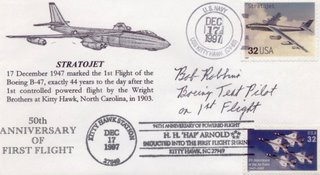
After famed Boeing Experimental Test Pilot Eddie Allen and his crew were killed in the 18 February 1943 fire and crash of the #2 XB-29, Robert M. Robbins became the next Boeing Experimental Test Pilot for the #1 XB-29 flight test program. During the last 22 months of World War II he was the Project Test Pilot and Aircraft Commander on every #1 XB-29 test flight - 312 flights totaling 458 hours. The #1 XB-29 was appropriately named "THE FLYING GUINEA PIG" because of its extensive use for experimental and developmental testing of new ideas and changes.
Bob Robbins will be remembered as being the Test Pilot of the XB-47 prototype that first flew on 17 December 1947, with fellow test pilot Scott Osler. The aircraft flew from Boeing Field in Seattle to the Moses Lake Airfield in central Washington State, in a flight that lasted 52 minutes. There were no major problems, except the newer radical design and shape made the plane hard to stop on the shorter runways back then until the drag chute concept was utilized. Bob had originally been skeptical about the XB-47, saying that before the initial flight he had "prayed to God to please help me" through the flight. The aircraft was so unusual that he simply didn't know if it would fly. Robbins presently realized that he had an extraordinary aircraft.
He finished phase one of the XB-47 program, then turned the program over to the Air Force in July of 1948. Guy Townsend was the Air Force test pilot who flew phase two.
He the got a job as assistant project engineer on the B-47B production program. From there it was typical project engineer and program management assignments for the next 30 years.
S/Ldr Jack Bertram Wales DFC,OBE,TD 1917-1956
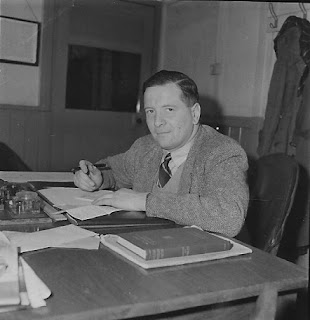
 The City of Manchester 613 Aux Squadron. Jack Wales sitting on wing.
The City of Manchester 613 Aux Squadron. Jack Wales sitting on wing.
Avro Vulcan Prototype VX770 Flown Cover,signed by Avro Test Pilot Sqn Ldr Jack Bertram Wales.
Jack Wales, O.B.E., D.F.C., T.D was a production test pilot with A. V. Roe, and had peformed important research flying in the three small Avro 707 aircraft which prepared the way for the Vulcan bomber.He made the maiden flight of Avro 707C WZ744 on 1st July 1953
Jack Wales was born in January, 1917. He joined the Armny in 1936 and was later commissioned in The Manchester Regimnent. In 1940 he was seconded to the Royal Air Force and served as a fighter pilot in India and the Far East, during which time he was awarded the Distinguished Flying Cross for gallant services. He joined 613 (City of Manchester) Squadron, Royal Auxiliary Air Force in 1945 and was appointed commanding officer of the squadron in 1949. In the same year he was awarded the Territorial Decoration. Three years later he was appointed O.B.E. for his services to the Royal Auxiliary Air Force. Before the war he had worked in the A. V. Roe company's experimental department and he rejoined the firm as a production pilot two years after the war. In the following years he had performed much of the highly arduous research flying necessary to the evolution of the company's delta winged aircraft - the Vulcan.Sqn Ldr Wales was killed on the 7th December 1956 when the prototype Avro Shackleton Mk3(WR970) crashed whilst on a test flight from Woodford,killing all onboard.
Peter J. Moneypenny 1927-Dec and Captain John William Hackett 1924-xxxx
 F.A.I. Official Record Cover Flown by Canberra.
F.A.I. Official Record Cover Flown by Canberra.Date 22 Feb 1958
Route Washington/Caracas in a time of 4h 10m 59s with average speed of 492.95mph
Aircraft Canberra T.4 Serial 2E-39
Crew:- Capt John William Hackett, Peter Moneypenny and Lt. Antonio Leyba of the FAV
At the end of 1952 the first contract for the export of British-built Canberras was signed—an order for six B.2s for Venezuela. The sale on January 27, 1953, was made at a comparatively early stage in the life of the aircraft, and it augured well for future overseas sales. At the 1952 S.B.A.C. display at Farnborough, the Venezuelans first saw the Canberra's remarkable qualities and so began negotiations to buy it. A second Venezuelan order was placed, and delivered, this time for a larger number of B.8s and T.4 dual-control trainers. It was while delivering the final one of the latter versions in 1958 that Mr. John Hackett, Mr. Peter Moneypenny, with Lt. Antonio Leyba of the Venezuelan Air Force, established the official point-to-point record from Washington, D.C., to Caracas.
Peter Moneypenny was one of three navigators that flew on the BAC TSR2
Friday, November 10, 2006
Air Cdre E M Donaldson CBE,DSO,AFC 1912-1992
E.M Donaldson

 Born in Malaya, his father was a judge and he was one of three brothers who would all serve as fighter pilots with the RAF. Educated in England, he then studied at McGill University in Canada, before joining the RAF in 1931, his first posting being to No 3 Squadron flying Bulldogs. In 1933 and 1935 he was awarded the 'Brooke-Popham Air Firing Trophy' and in 1935 he was a member of the 3 Squadron aerobatic team of five Bulldogs using smoke.
Born in Malaya, his father was a judge and he was one of three brothers who would all serve as fighter pilots with the RAF. Educated in England, he then studied at McGill University in Canada, before joining the RAF in 1931, his first posting being to No 3 Squadron flying Bulldogs. In 1933 and 1935 he was awarded the 'Brooke-Popham Air Firing Trophy' and in 1935 he was a member of the 3 Squadron aerobatic team of five Bulldogs using smoke.In early 1937 he was tasked with reforming No 72 Squadron at Tangmere with Gloster Gladiators but when the squadron moved North to Church Fenton, he remained at Tangmere being appointed a flight commander in No 1 Squadron where he immediately set about forming a formation aerobatic team consisting of four Furies. From No 1 Squadron he moved to the CFS and having qualified as QFI, he returned to operational flying with No 151 Squadron. When he arrived the squadron was equipped with the Gloster Gauntlet but shortly after his arrival re-equipment began with Hurricanes. This also coincided with his promotion to Squadron Leader and appointment as CO.
His short operational career during WW2 resulted in him claiming five confirmed victories, with one more shared, three unconfirmed and one damaged. As OC of RAF Colerne, he commanded the first wing of jet fighters in the RAF.
During the war, most of the pre-war records had been broken, even if not recorded officially, and the RAF decided to recapture the World Speed record with its new generation of jet aircraft. They consequently set a new High Speed Flight with Group Captain Donaldson in command and on 7 September 1946, he established a new World Record of 615.78 mph in a Meteor.
After retirement, he became Air Correspondent for the Daily Telegraph until 1979.
 World Record of 615.78 mph in a Meteor on 7 September 1946,flown by E.M.Donaldson
World Record of 615.78 mph in a Meteor on 7 September 1946,flown by E.M.Donaldson
Bruce Hinds 1939-
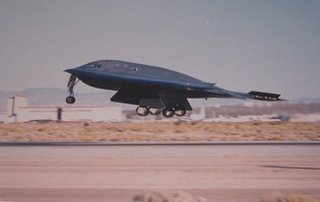 On 17 July 1989, Northrop Chief Test Pilot Bruce Hinds, along with B-2 Combined Test Force Director, Colonel Rick Couch, lifted the B-2 Spirit off the runway at Palmdale, California on its maiden flight. The B-2 was as awesome as the XB-35 and YB-49 were during the forties. After a series of standard flight test maneuvers, the aircraft was landed at Edwards AFB to undergo further testing
On 17 July 1989, Northrop Chief Test Pilot Bruce Hinds, along with B-2 Combined Test Force Director, Colonel Rick Couch, lifted the B-2 Spirit off the runway at Palmdale, California on its maiden flight. The B-2 was as awesome as the XB-35 and YB-49 were during the forties. After a series of standard flight test maneuvers, the aircraft was landed at Edwards AFB to undergo further testing
Bruce Hinds made aviation history as the first man to fly the Northrop B-2 Spirit, an aircraft whose unusual design could be traced back 50 years! Hinds was born in 1939 and grew up in Denver, Colorado. A 1961 graduate of the Air Force Academy, he earned his wings at Vance AFB, Oklahoma. Then, he checked out in the Lockheed C-130 Hercules and was assigned to Charleston AFB, South Carolina. Next, from Goose Bay AB, Labrador, he flew the C-130 equipped with the Fulton Recovery System and participated in NASA’s Gemini spacecraft recoveries. In 1967, he attended the Aerospace Research Pilot School at Edwards AFB, California, and then was assigned to Test Operations.
He flew in many programs, from C-130 airdrops to tests of BAK-13 landing barriers. In 1970, he was sent to Thailand and flew another version of the C-130. Back at Edwards AFB in 1971, Hines became a project pilot in the Lockheed C-5 Galaxy test force. He eventually became Operations Officer and finally Test Force Director for the C-5. He was project pilot in 1974 on a spectacular mission, the launching of a Minuteman missile from the C-5! This test became a bargaining chip in negotiations on strategic arms reduction with the Soviet Union. In 1976, he flew both the Boeing YC-14 and the McDonnell Douglas YC-15.
Hinds became Operations Officer, in 1977, for the Airborne Warning and Control System (AWACS) test force. Returning to Test Operations in 1978, he became the Chief of Bomber, Transport and V-STOL Testing. Next, he became Test Force Director for the McDonnell Douglas KC-10 Extender. At completion of tests on the KC-10, he became Deputy for Strategic Test in the 6510th Test Wing. In 1982, Hinds retired from the Air Force and went to work at Northrop Corporation. Security was so tight, that company executives could not even tell him what his position would involve! Eventually, he learned that he was to be the Chief Test Pilot on the Advanced Technology Bomber program. After test flying the B-2, Hinds worked in management at Northrop from 1991 to 1994.
In 1942, the N9M had been a trainer and test bed for the Northrop XB-35 and YB-49. These advanced flying wings contributed greatly to the design of the B-2 stealth bomber. In 1995, he flew the N9M at Edwards AFB, where it posed next to its great-grandson. Hinds has more than 12,000 hours flying time in over 70 aircraft types.
Forrest S. Petersen, 1922-1990


Forrest Petersen was born in Holdrege, Nebraska on 16 May 1922. He is the son of Mrs. Stella B. Petersen who lives in Gibbon, Nebraska. Prior to entering the Navy he attended the University of Nebraska.
He was commissioned an Ensign upon graduation from the United States Naval Academy in June of 1944 and reported to the destroyer USS CAPERTON (DD 650). While serving aboard CAPERTON he participated in campaigns in the Philippines, Formosa and Okinawa. After graduation from flight training in 1947, he was assigned to Fighting Squadron Twenty Able which was later redesignated Fighter Squadron ONE NINETY TWO.
He was selected for Post Graduate training in Aeronautical Engineering in July 1950 and upon completion of two years of study at the Naval Post Graduate School was awarded a Bachelors Degree (AE). He continued studies for one year at Princeton University and received a Masters Degree in Engineering. From 1953 to 1956 he served with Fighter Squadron FIFTY ONE. In 1956 he was selected to attend the Naval Test Pilot School and remained as an instructor following graduation. in August 1958 he was assigned duties as Research Pilot in the X-15 Program and served with the National Aeronautics and Space Administration Flight Research Center at Edwards, California until January 1962. During that time he made five free flights in the X-15 and achieved a speed of 3,600 MPH (Mach No. 5.3) and an altitude of about 102,000 feet. Captain Petersen was the only Navy pilot to fly the X-15. In July 1962 he was a joint recipient of the Collier Trophy which was presented by President John F. Kennedy and the NASA Distinguished Service Medal which was presented by Vice President Lyndon B. Johnson.
Captain Petersen served as Commanding Officer of Fighter Squadron ONE FIFTY FOUR prior to being assigned to the office of Director, Division of Naval Reactors, AEC for Nuclear Power Training. He reported to USS ENTERPRISE in January 1964 and served therein as Executive Officer until April 1966. He was awarded the Bronze Star for duty during ENTERPRISE's first combat tour in Vietnam. He was then assigned duties as an Assistant to the Director of Naval Program Planning in the office of the Chief of Naval Operations. In November 1967 he assumed command of USS BEXAR (APA 237) in the Pacific Fleet Amphibious Forces. Following an eight month deployment with the Seventh Fleet Amphibious Forces in the Western Pacific he was awarded the Navy Commendation Medal with Combat V. Petersen holds the following awards for service in World War II, Korean War and the Vietnam War:
Legion of Merit, Distinguished Flying Cross, Bronze Star, NASA Distinguished Service Medal, Navy Commendation Medal, American Defense, Pacific Theatre, American Theatre, Asiatic Theatre, China Service, Japanese Occupation, Philippine Liberation, Philippine Presidential Unit Citation, World War II Victory, Korean Service, United Nations Korean Service, Vietnam Service, Vietnamese Campaign.
John W.Allam OBE FRAes 1924 –2019
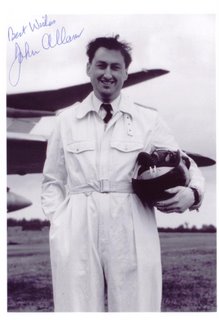 John Allam standing in front of the Victor Prototype
John Allam standing in front of the Victor Prototype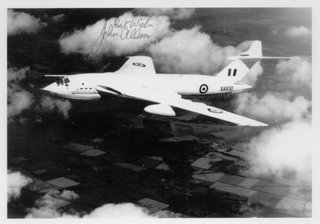 Victor B Mk2 in flight
Victor B Mk2 in flight Victor B Mk2 in flight
Victor B Mk2 in flight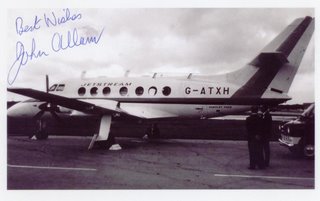 Conceived in 1965 the prototype, G-ATXH, first flew (as the HP137) from Radlett under the control of the chief test pilot, John Allam, on 18 August 1967.
Conceived in 1965 the prototype, G-ATXH, first flew (as the HP137) from Radlett under the control of the chief test pilot, John Allam, on 18 August 1967.John Allam was born in 1924 and was educated at Churcher’s College,Hampshire and Christ’s College in Cambridge. He joined the RAF Volunteer reserve in 1943,undertaking flying training at No6 FTS in Oklahoma,USA flying PT17 Stearman and AT6 Harvard aircraft.
He was commissioned into the RAFVR in 1944, becoming a QFI in 1945 at RAF Windrush. From 1945-1954 he served in various roles including Captain of VIP Dakota based in Pakistan before joining ETPS on No9 course and then No6 course at USN Test Pilot School.
In 1954 he joined Handley Page Limited as assistant Test Pilot on the Victor prototype and Victor B Mk1 development test programme. He made the maiden flight of the first production Victor B Mk1 in 1956. The same year he was appointed Deputy Chief Test Pilot with overall responsibility for the Victor B Mk1 and B Mk2 development test programme. On the 1st June 1957 he exceeded Mach 1 in a Victor BMk1,making it the first ever supersonic 4 jet aircraft!
He made the maiden flight of the Victor B Mk2 in 1959 and of the Herald 200 in 1961. In 1965 he was appointed Chief Test Pilot and assumed overall responsibility for the HP Jetstream development programme. He made the maiden flight of the aircraft on 18th August 1967.
